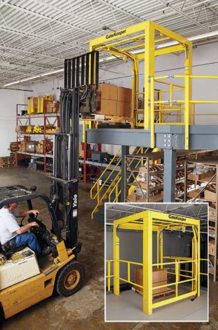Dual reciprocating barrier
What’s a dual reciprocating barrier, and why do workplaces with an elevated platform or mezzanine need one?

Responding is Andy Olson, director of marketing, Rite-Hite Engineered Solutions, Rite-Hite Corp., Milwaukee.
Before explaining what a dual reciprocating barrier is, it’s best to discuss the basics of what it does. A dual reciprocating barrier creates a controlled access area for people or product to enter one side of the area, but not the other. When applied to mezzanines and elevated work platforms, it becomes essential to maintaining safe traffic flow and preventing potentially catastrophic fall hazards.
Fall hazards consistently rank as one of the most common causes of serious work-related injuries and death, according to OSHA. In fact, slips, trips and falls account for 15% of all incidental deaths, with falls accounting for 80% of such deaths.
In short, protecting workers and products from falling at height is critical to maintaining a safe work environment.
Guardrails are the easiest way to protect workers from falling off elevated platforms. However, in many industrial and commercial storage situations, it’s essential to move product up to and down from elevated platforms. This is where dual reciprocating barriers become necessary.
Leading models use a link bar design to ensure the inner gate works in tandem with the outer gate. When one side is open, the other side is closed; they can’t be open at the same time. For example, if a fork truck is lifting a pallet to an elevated platform, the outer gate will be open to receive it, while the inner gate closes to keep workers out. When the pallet has been safely placed in the control area, mezzanine-level workers can open the inner gate, which simultaneously closes the outer gate. The pallet then can be unloaded in the elevated work area. This process works in reverse, as well.
Some dual reciprocating barriers have automatic operations, but manual barriers are relatively easy to use. Getting a dual reciprocating barrier that has a raised toe board for additional fall protection is recommended, because materials can still be pushed off an elevated edge without one.
In addition to minimizing risk for workers, dual reciprocating barriers comply with OSHA’s walking-working surfaces regulation. They also comply with ANSI standard MH28.3: 2009, which states that any gate providing access opening through the guards for the purpose of loading and unloading material onto a work platform shall be designed such that the elevated surface is protected by guards at all times. Gates that simply swing open, slide open or are left out are not acceptable because they leave the opening unprotected.
Like mezzanine fall protection, pick modules should use a similar type of dual reciprocating barrier. These are typically modified to fit within the existing racking structure, and often take up a small amount of space.
Protecting workers with dual reciprocating barriers will minimize fall hazard risks and keep facilities in compliance.
Author’s Note: The information herein is provided as a general reference regarding the use of the applicable product(s) in specific applications. This information is provided without warranty. It is your responsibility to ensure you are using all mentioned products properly in your specific application and in accordance with all laws and regulations.
Editor's note: This article represents the independent views of the author and should not be construed as a National Safety Council endorsement.
Post a comment to this article
Safety+Health welcomes comments that promote respectful dialogue. Please stay on topic. Comments that contain personal attacks, profanity or abusive language – or those aggressively promoting products or services – will be removed. We reserve the right to determine which comments violate our comment policy. (Anonymous comments are welcome; merely skip the “name” field in the comment box. An email address is required but will not be included with your comment.)

